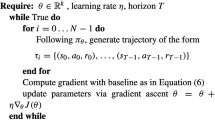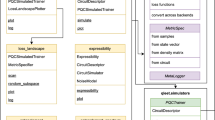Abstract
Recently, a variational learning approach is adopted to discover quantum communication protocols (Wan et al. in npj Quantum Inf 3:36, 2017). Because designing quantum protocols manually is a delicate and difficult work, this variational learning approach is well worth further study. In this paper, we use the same approach to learn the simultaneous dense coding (SDC) protocols with two or three receivers. The gradient-based optimization is used to learn the parameters of the locking operator of the SDC protocol. Two different designs of the loss function are considered. Numerical experiment results show the effectiveness of this variational learning approach.


Similar content being viewed by others
References
Biamonte, J., Wittek, P., Pancotti, N., Rebentrost, P., Wiebe, N., Lloyd, S.: Quantum machine learning. Nature 549, 195 (2017)
Nielsen, M.A., Chuang, I.L.: Quantum Computation and Quantum Information. Cambridge University Press, Cambridge (2000)
Bishop, C.M.: Pattern Recognition and Machine Learning. Springer, Berlin (2006)
Wan, K.H., Dahlsten, O., Kristjánsson, H., Gardner, R., Kim, M.S.: Quantum generalisation of feedforward neural networks. npj Quantum Inf. 3, 36 (2017)
Cincio, L., Subasi, Y., Sornborger, A.T., Coles, R.J.: Learning the quantum algorithm for state overlap. New J. Phys. 20, 113022 (2018)
Morales, M.E.S., Tlyachev, T., Biamonte, J.: Variational learning of Grovers quantum search algorithm. Phys. Rev. A 98, 062333 (2018)
Situ, H.Z., Qiu, D.W.: Simultaneous dense coding. J. Phys. A Math. Theor. 43, 055301 (2010)
Situ, H.Z.: Controlled simultaneous teleportation and dense coding. Int. J. Theor. Phys. 53, 1003 (2014)
Situ, H.Z., Qiu, D.W., Mateus, P., Paunkovic, N.: Secure N-dimensional simultaneous dense coding and applications. Int. J. Quantum Inf. 13, 1550051 (2015)
Zhang, C., Situ, H.Z., Li, Q., He, G.P.: Efficient simultaneous dense coding and teleportation with two-photon four-qubit cluster states. Int. J. Quantum Inf. 14, 1650023 (2016)
Yang, X., Bai, M.Q., Zuo, Z.C., Mo, Z.W.: Secure simultaneous dense coding using \(\chi \)-type entangled state. Quantum Inf. Process. 17, 261 (2018)
Huang, Z.M., Zhang, C., Situ, H.Z.: Performance analysis of simultaneous dense coding protocol under decoherence. Quantum Inf. Process. 16, 227 (2017)
Huang, Z.M., Ye, Y.Y., Luo, D.R.: Simultaneous dense coding affected by fluctuating massless scalar field. Quantum Inf. Process. 17, 101 (2018)
Kingma, D.P., Ba, J.: Adam: a method for stochastic optimization. arXiv: 1412.6980
Duchi, J., Hazan, E., Singer, Y.: Adaptive subgradient methods for online learning and stochastic optimization. J. Mach. Learn. Res. 12, 2121 (2011)
Tieleman, T., Hinton, G.: Lecture 6.5—RMSProp, COURSERA: neural networks for machine learning. Technical report (2012)
Acknowledgements
We are very grateful to the reviewers and the editors for their invaluable comments and detailed suggestions that helped to improve the quality of the present paper. This work is supported by the National Natural Science Foundation of China (Nos. 61772565, 61602532, 61871205), the Innovation Project of Department of Education of Guangdong Province of China (No. 2017KTSCX180), the Jiangmen Science and Technology Plan Project for Basic and Theoretical Research (No. 2018JC01010) and the Science and Technology Project of Jiangmen City of China (No. 2018JC01019).
Author information
Authors and Affiliations
Corresponding author
Additional information
Publisher's Note
Springer Nature remains neutral with regard to jurisdictional claims in published maps and institutional affiliations.
Appendix
Appendix
This “Appendix” gives the solutions for SDC2R and SDC3R found by our methods. Because our method is inherently stochastic, different runs of the experiment give different optimal solutions. Here, we list one optimal solution for SDC2R and one optimal solution for SDC3R, respectively.
The known unlocking operators for SDC2R in the previous literature include quantum Fourier transform [7], double controlled-NOT [9] and SWAP [9] operators. The quantum circuits for these three unlocking operators are already known. In contrast, the optimal solutions found by our method need to be compiled into quantum circuits or implemented by special quantum devices. However, our method is quite useful for constructing unlocking operators for SDC protocols with more than two receivers.
Rights and permissions
About this article
Cite this article
Situ, H., Huang, Z., Zou, X. et al. Variational learning the SDC quantum protocol with gradient-based optimization. Quantum Inf Process 18, 230 (2019). https://doi.org/10.1007/s11128-019-2348-9
Received:
Accepted:
Published:
DOI: https://doi.org/10.1007/s11128-019-2348-9




